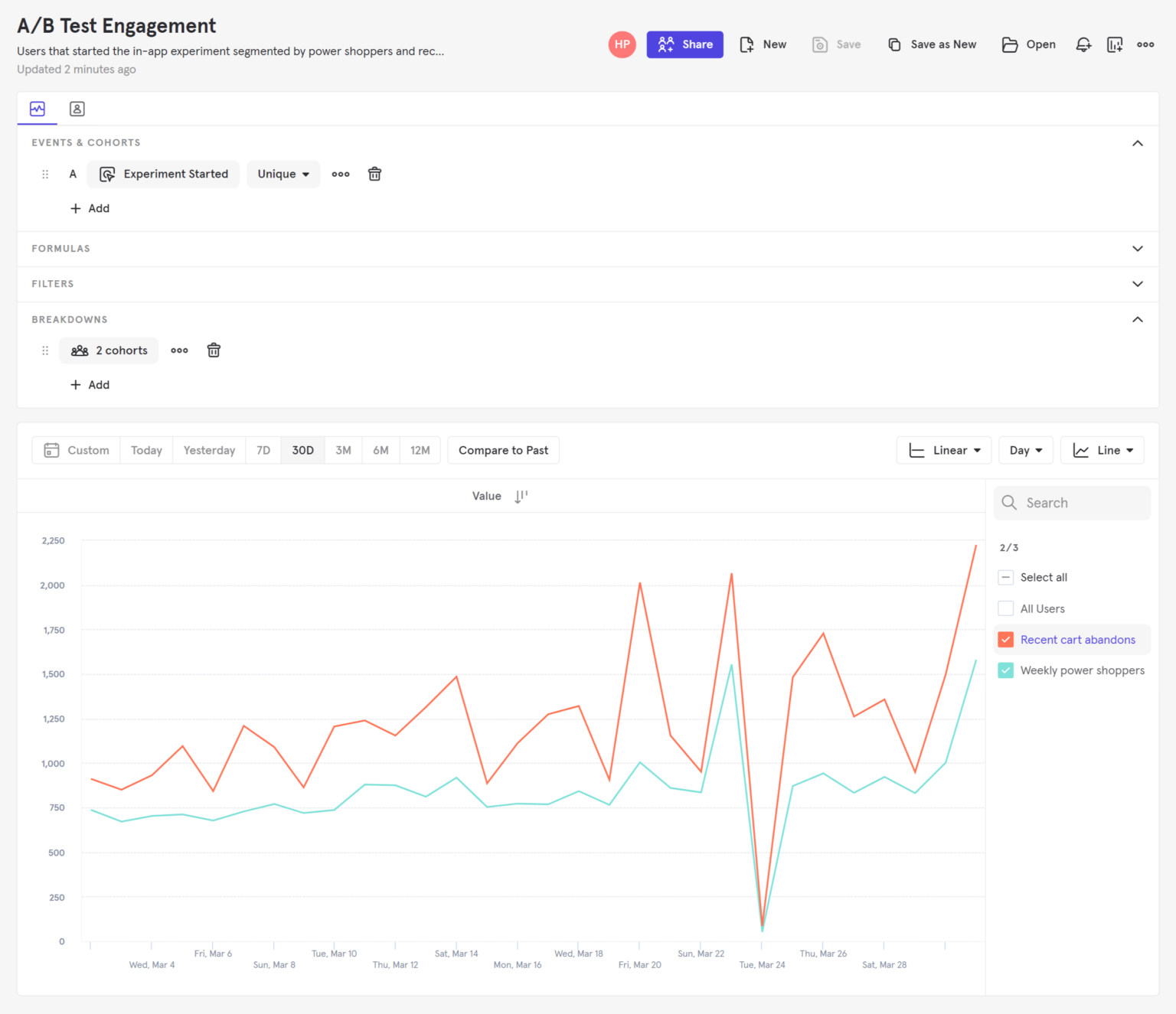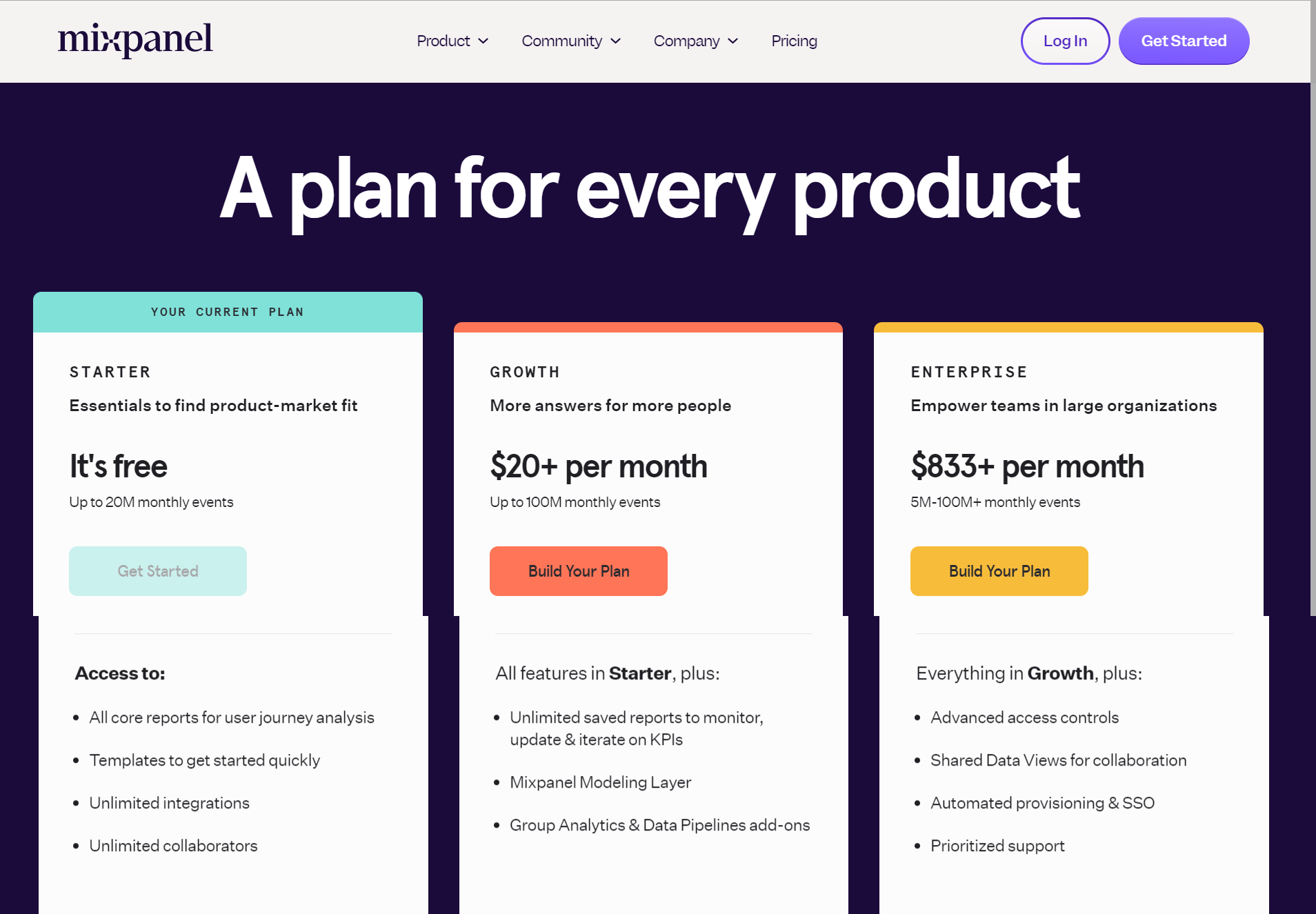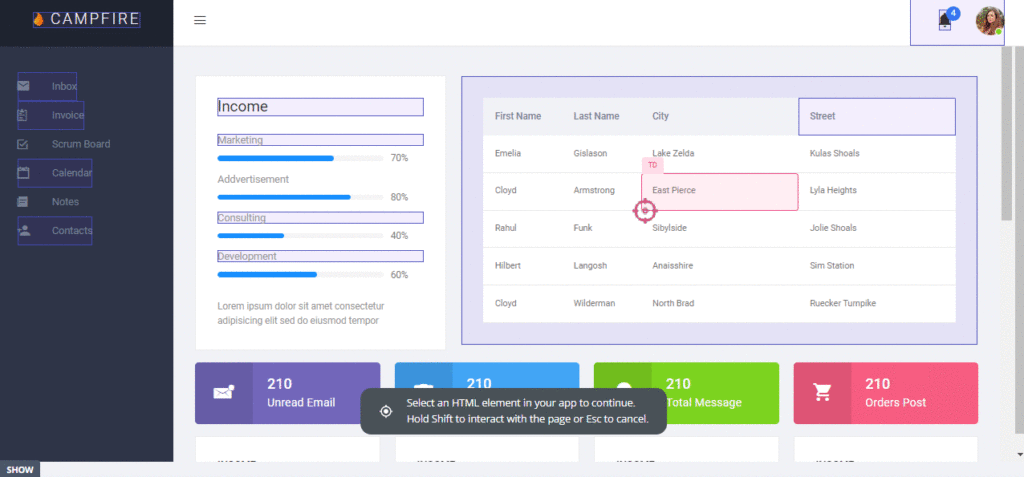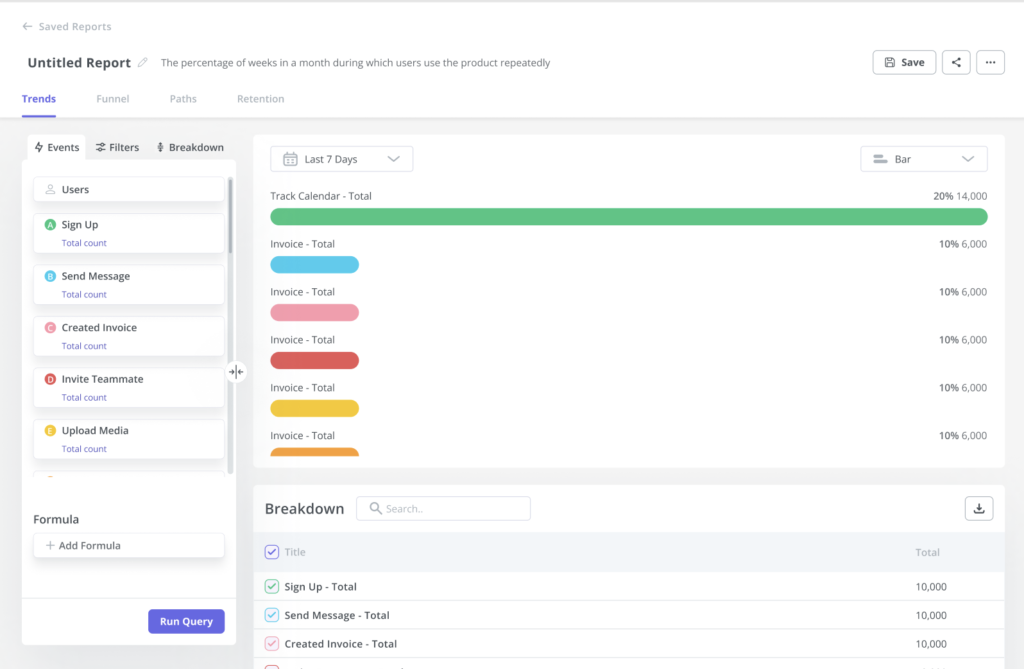
Looking for a good user engagement analysis tool and wondering which one of Heap, Amplitude, and Mixpanel is the best option for your SaaS company? Let’s compare them!
There are plenty of tools for user engagement analysis on review sites, but they don’t make the choice any easier.
The crux of the issue is – to make the right choice, you need to account for your priorities: your different jobs to be done, budget, and the size of your company. But don’t worry – we’re coming to help!
In this post, we’ll discuss exactly that – which tool is best for user engagement analysis depending on the different criteria that different SaaS companies may have.
Let’s dive in!
Try Userpilot Now
See Why 1,000+ Teams Choose Userpilot

Overview of Heap vs Amplitude vs Mixpanel for user engagement analysis
- User engagement analysis is the process of studying how your customers interact with your product, allowing you to gain useful insights into their behaviors and motives.You can understand what resonates with your users by measuring and analyzing user actions such as product usage and time spent. This enables you to improve their experience, optimize important moments, and make data-driven decisions that drive growth and satisfaction.
Let’s explore how Heap, Amplitude, and Mixpanel compare when it comes to user engagement analysis.
- Heap is a robust product analytics platform that provides users with a plethora of in-depth insights into customer behavior and needs. With Heap, you can track user interactions in real time across all touch points within your product.
- Amplitude is a powerful analytics tool that gives organizations in-depth, real-time insights into product usage and user behavior. It offers various features, including event segmentation, funnel analysis, user cohorts, and retention analysis.
- Mixpanel is a simple and powerful product analytics tool that allows product teams to track and analyze in-app product engagement. It allows your team to see every moment of the customer experience clearly, so you can make changes that work.
- Userpilot is a product growth platform that drives user activation, feature adoption, and expansion revenue. It also helps product teams collect user feedback, streamline onboarding, and gather actionable insights from analytics.
- If you’re looking for a better option for user engagement analysis, Userpilot exceeds both functionality and value for money compared to other tools on the list. Get a Userpilot demo for user engagement analysis and drive your product growth code-free.
What is user engagement analysis
User engagement analysis is the process of studying how your customers interact with your product, allowing you to gain useful insights into their behaviors and motives.
You can understand what resonates with your users by measuring and analyzing user actions such as product usage and time spent. This enables you to improve their experience, optimize important moments, and make data-driven decisions that drive growth and satisfaction.
Heap for user engagement analysis
Monitoring user behavior can be instrumental in helping you understand how users interact with different elements and features. Also, it offers insight into various paths users take to navigate your product. That, in turn, can help you identify users who repeat an action, reach a goal, or churn.
Heap facilitates user behavior analysis with the following tools:
- The Autocapture feature tracks user actions and collects event data as soon as you install Heap into your product. You need not set up custom events. That means you can monitor user behavior retroactively.
- Session Replays and Heatmaps provide you with an in-depth overview of how users navigate your product, including the actions they take and the roadblocks they face.
- With the Usage over time chart, you can monitor how different user segments interact with your product and even compare the behavior of different segments.
Heap pros
As a cutting-edge digital insights platform, Heap offers several valuable features for product developers, marketers, and customer success teams. Let’s take a closer look at its benefits.
- Automated data capture – Heap’s Autocapture feature lets you automatically track user actions, such as clicks, swipes, page views, and form submissions. That means you don’t have to worry about setting up custom tracking for each event. Also, you can track events retroactively.
- Easy setup – Getting started with Heap is as easy as installing a code snippet into your product. In other words, you don’t need a lot of technical knowledge or expertise.
- Advanced analytics – Besides Autocapture, Heap also lets you track custom events and services-side events to help you build a comprehensive user behavior data set. With features like Heatmaps and Session Replays, it results in unparalleled insights into how users navigate your product and the paths that lead to desired outcomes.
- Real-time insights – With the Live data feed, you get a chronological and real time view of all Heap events (raw and labeled). That means you can track and analyze user interactions as they happen.
- Seamless collaboration – Features like Shared Spaces facilitate collaboration and reporting among cross-functional teams. Similarly, you can share Session Replays with other team members.
- Web and mobile support – Heap works on all kinds of products, be it websites, web applications, or mobile apps.
- Extensive integrations – Heap supports integrations with more than 100 platforms, including customer engagement tools, data warehouses, product adoption tools, etc.
- Emphasis on customer education – Heap provides a variety of helpful resources to get you get started with the platform and use it to the fullest. These include Heap University (video tutorials), Heap Plays (how-to guides), Help Center, and a comprehensive blog and content library.
Heap cons
Heap comes with an impressive set of features that provide you with a 360-degree view of how users navigate your product and interact with various elements. But the product analytics platform isn’t without limitations.
Here are a few drawbacks of Heap worth mentioning:
- Steep learning curve – While the setup is a cakewalk, Heap involves a fairly steep learning curve due to its vast array of features. As a new user, it’ll take you a while to get a grip on all its features.
- Data storage requirements – Heap’s Autocapture feature requires you to collect and store a ton of data. Things can get expensive quickly as your product attracts new users.
- Lack of an engagement layer – While Heap offers an in-depth overview of user behavior and product usage, it doesn’t let you act on these insights. You’ll need other customer engagement tools to trigger targeted in-app experiences based on data and insights from Heap.
- Limited segmentation capabilities – Heap lets you segment users based on events and properties. It can be restrictive when you want to build hyper-personalized user journeys.
Heap pricing
Pricing for Heap is available on request. You’ll have to contact the sales team for a quote. The final price will depend on various factors, including the number of sessions and integrations you need.
That said, Heap offers a free plan that lets you track up to 10,000 user sessions per month and stores your data for 6 months. Review platforms like G2 say that paid plans start at $3,600 per year. All paid plans come with a 14-day free trial, too.
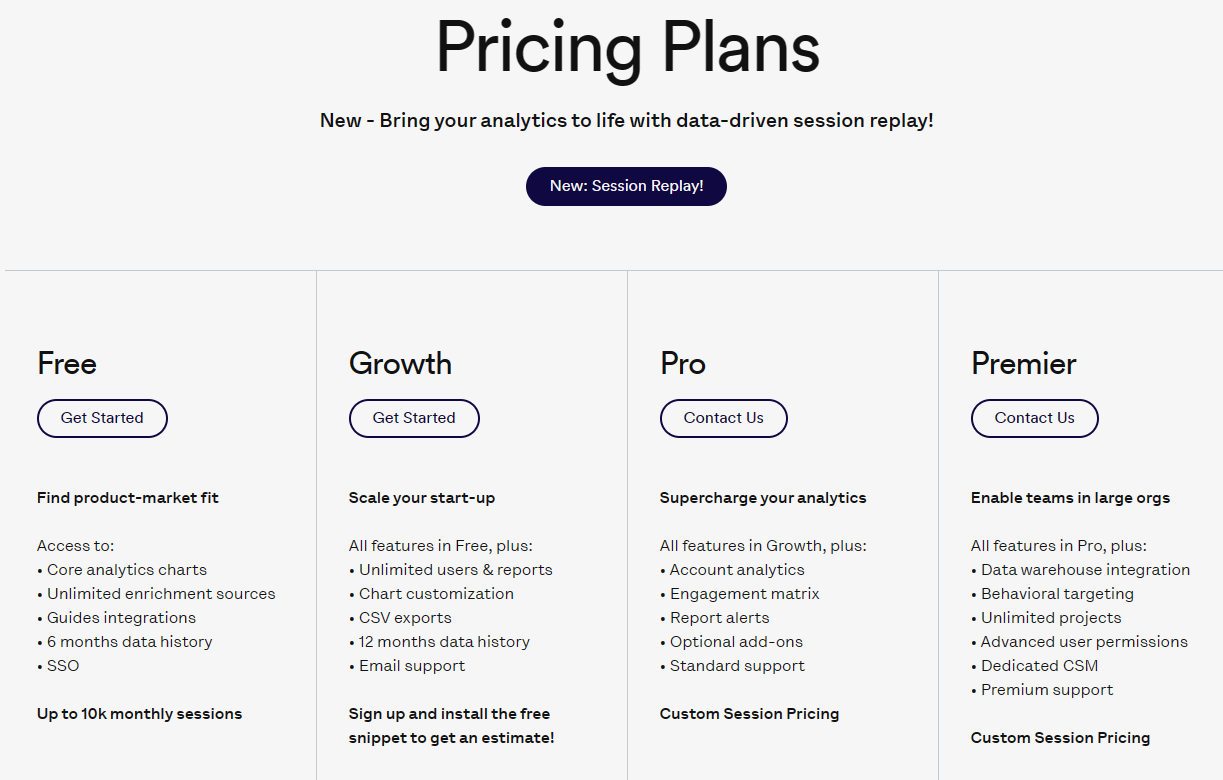
You can choose from the following plans:
- Free – Ideal for teams looking to establish product-market fit.
- Starter – Suitable for startups looking to scale their business.
- Growth – Useful for companies that need advanced features, such as account analytics and report alerts.
- Pro – Tailored for enterprise businesses with robust security and compliance requirements.
It’s worth mentioning here that Heap offers a handy ROI calculator to help you get a clearer picture of whether it’s worth the investment.
Amplitude for user engagement analysis
With Amplitude, you can take a deep dive into user activity and behavior. You can generate relevant reports to identify patterns and actionable insights based on user data.
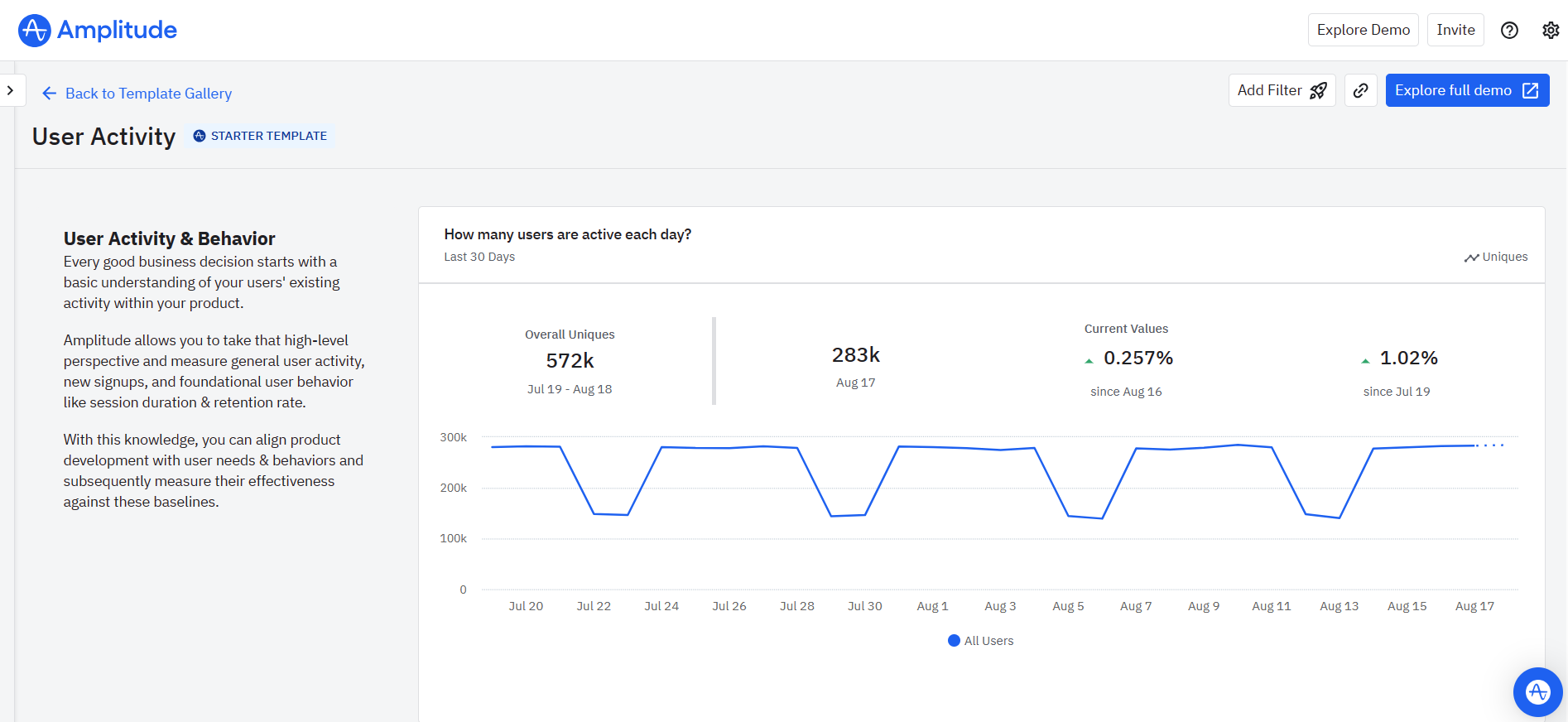
Besides tracking user activity, the following functionalities of Amplitude help you conduct advanced behavioral analytics:
- Retention and stickiness analysis
- Predictive analytics
- A/B testing
- Funnel analysis
With detailed reports available for each, you can understand your users better and provide them with exactly what they want, leading to a better user experience.
Amplitude pros
Amplitude is one of the most feature-packed stand alone product analytics platforms for digital products at the moment. It’s designed to meet the needs of modern product and growth teams that want to embrace data-driven decision-making.
Let’s take a closer look at the benefits of Amplitude:
- Advanced product analytics – Amplitude enables you to dig deep into user behavior, including how they interact with your product and where they convert or drop off.
- Cross-platform analytics – Amplitude lets you track product usage across native apps, web apps, and web pages. It can help you understand how users move between these platforms.
- Designed for collaboration – It enables you to easily share dashboards and reports with other team members. Amplitude also facilitates collaboration among different teams, including product, marketing, and customer success.
- Powerful integrations – Amplitude connects with more than a hundred platforms, including data warehouses, marketing automation tools, ad networks, and customer data platforms. This helps you harness the full potential of product and user behavior data.
- Customer education – Amplitude offers an extensive resource center and a community where you can connect with product analytics experts. Moreover, you get easy access to a chatbot and help center from your dashboard.
Amplitude cons
Despite its impressive suite of features, Amplitude comes with a few drawbacks. These include:
- Steep learning curve – Amplitude’s fully customizable dashboards can be intimidating for new users. You’ll need basic technical knowledge to set up and track events using Amplitude. It may not be particularly suitable for teams without in-house analysts.
- No user engagement functionalities While Amplitude offers a ton of user behavior data, it doesn’t provide any tools to act on these insights. In contrast, a product adoption platform like Userpilot lets you harness usage and behavior data to optimize in-app experiences.
- Lack of automated event tracking – Amplitude doesn’t automatically track events like clicks, page views, and swipes. You have to define the events you want to track before getting started.
Amplitude pricing
Amplitude offers three distinct pricing tiers:
- Starter – A free plan suitable for small teams.
- Growth – Suitable for teams that need to scale fast; pricing is available on request and depends on your requirements.
- Enterprise – Includes advanced governance and security features; pricing is available on request.
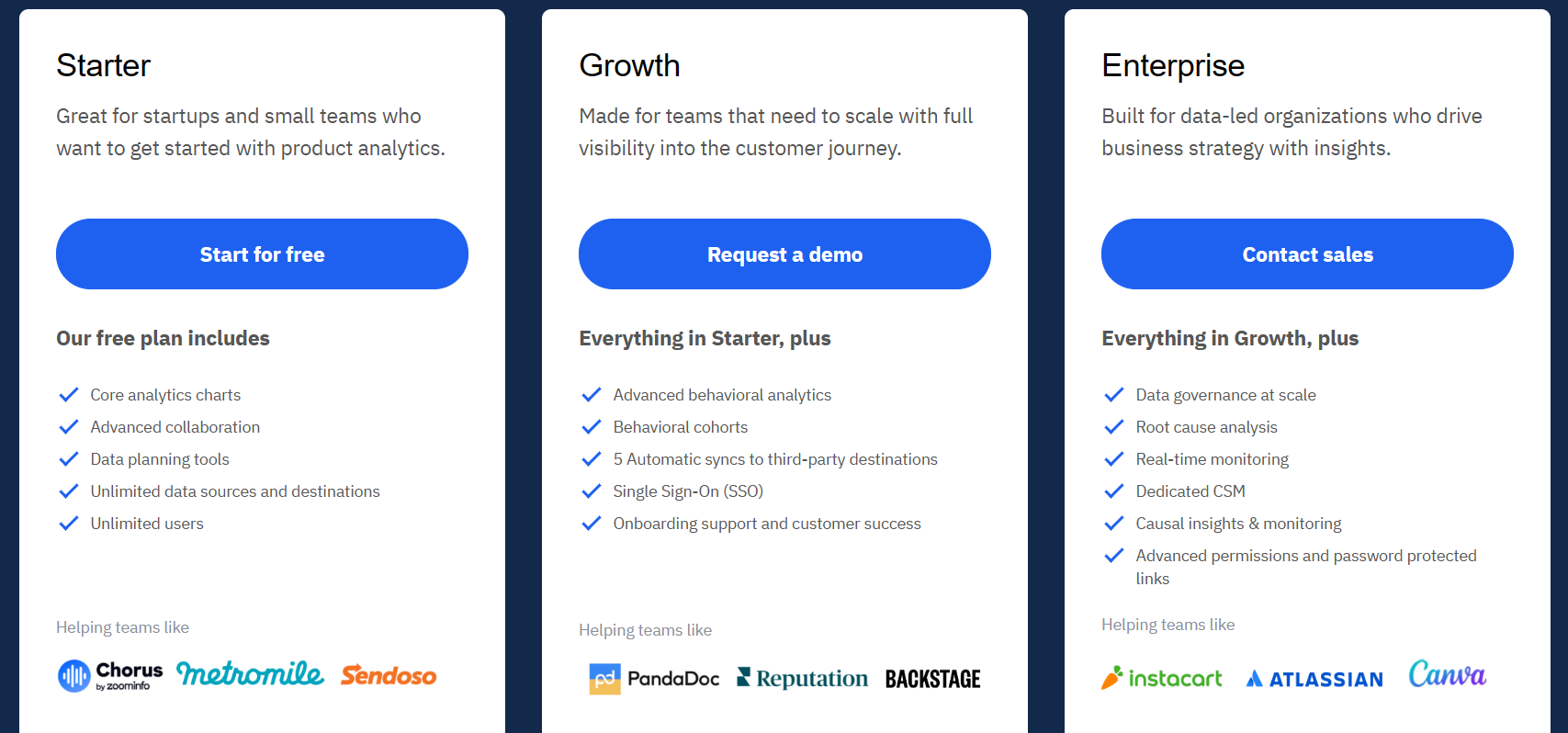
Both Growth and Enterprise plans come with a 14-day free trial. Amplitude also offers a free annual subscription to the Growth plan under the following programs:
- Scholarship Program for startups with under $5 million in funding and fewer than 20 employees.
- Black Founders Program for US startups with a Black co-founder, fewer than 150 employees, and under $30 million funding.
However, it’s worth noting that Amplitude’s pricing plans are complex because they’re based on the number of monthly events or features. Other tools like Mixpanel and Userpilot offer more transparent pricing based on the number of monthly active users.
Mixpanel for User engagement analysis
Mixpanel has features for behavioral analytics that help product teams and developers understand users’ actions.
Below are features that are accessible for use when analyzing user behavior on Mixpanel:
- Funnels: To track users’ progress toward outcomes such as purchases or signups, Mixpanel’s funnel feature can help you with funnel reports. Funnels display a series of stages in a user journey and how many users progress from one stage to the next—for example, from download to sign up and purchase. If one stage has a low conversion rate, it’s a signal that that stage needs attention.
- A/B test segmentation: Mixpanel’s segmentation helps teams build more complete customer profiles and create cohorts (defined segments of users based on common important characteristics or experiences). Armed with this information, you can adjust your product and marketing to better address the specific needs of each segment or of the business.
- Data association: Each data point corresponds to a unique user ID, connecting events like sign-ups, cart additions, and interactions.
- Data customization: Mixpanel’s customizable data parameters allow precise user behavior insights, enabling behavioral segmentation for targeted campaigns.
- User activity tracking: Daily, weekly, and monthly active user reports (DAU, WAU, MAU) provide insights into user engagement trends.
- Integration flexibility: Mixpanel seamlessly integrates with tools like Segment, streamlining data sharing. SDKs and an import API further enhance data management.
Mixpanel pros
Let’s have a look at the pros of using Mixpanel:
- Sophisticated features that enable granular data analysis are a significant advantage of using Mixpanel because they allow you to gain deeper insights into user behavior, interactions, and trends. For example, with the event tracking feature, you can track user sign-ups, product purchases, clicks on specific buttons, and more.
- Unlimited segmentation capabilities: It offers unlimited segmentation capabilities on attributes, user properties, and cohorts. This level of segmentation gives you a more detailed view of your consumers and their engagement level.
- Easy-to-navigate UI patterns: The user interface of this platform is simple and has a wide variety of functions and resources to help you work in the most organized way, have better team coordination, and keep efficiency high.
- Seamless onboarding for your product team: Getting started on Mixpanel is easy and without stress. Register, choose a plan, or hop on for a free trial.
- A free plan that is sufficient for small SaaS companies: This free plan offers valuable features and resources — unlimited integrations, unlimited collaborators, templates, and essentials to get started quickly — that can help you gain insights into user behavior and make data-driven decisions, even when operating with limited budgets.
- Powerful interactive and easily accessible visuals: For quicker decision-making to beat analysis paralysis.
Mixpanel cons
While Mixpanel is a powerful product analytics tool with many great features, there are still some downsides. Here are the main cons of the tool:
- The free plan works well for small SaaS businesses, but enterprise-grade features can be expensive depending on your needs.
- You will need the help of your engineering team to set up and configure the tool — The platform’s advanced functionalities, custom event tracking and segmentation, might require a steeper learning curve, especially for those without a strong background in data analysis.
- Limited Attribution Models: While Mixpanel offers various analytics features, its attribution modeling capabilities might be more limited.
- There is no user feedback or engagement functionality, so you need third-party tools.
Mixpanel pricing
Mixpanel’s pricing plan is divided into 3 plans; the starter plan, the enterprise plan, and the growth plan.
Here’s an overview of the pricing plans and features of each plan:
- Starter plan: This plan features essentials to find product-market fit. It is free and allows up to 20M monthly events. In addition, you get access to all core reports for user journey analysis, templates to get started easily, unlimited integrations, and unlimited collaborators.
- Growth plan: This plan costs $20+ per month for up to 100M monthly events. You get all features in the starter plan plus unlimited saved reports to monitor, update, and iterate on KPIs, Mixpanel modeling layer, and group analytics and data pipeline add-ons.
- Enterprise plan: This plan empowers your team, especially if you have a large organization. It costs $833+ per month for up to 5M-100M+ monthly events. This plan features all the benefits of the growth plan plus advanced access controls, shared data views for collaboration, automated provisioning and SSO, and prioritized support.
Better alternative to Heap, Amplitude, and Mixpanel
We have discussed Heap, Amplitude, and Mixpanel for user engagement analysis with their pros, cons, and pricing. Let’s take a look at a better alternative – Userpilot.
Userpilot for user engagement analysis
Behavioral analytics make it possible to monitor user activity, group data into cohorts, and extract relevant metrics/insights. Userpilot lets you tag features to see how users interact with them, compare goals by cohort, and create trend reports that track behavioral patterns over time.
Here are some Userpilot features you can use for user behavior tracking:
- No-Code Feature Tagging: Userpilot’s click-to-track feature tagger lets you mark features, buttons, and elements with the Chrome extension. You’ll be able to track user interactions such as clicks, hovers, or inputs to get an accurate behavioral view for specific features.
- Funnel Reports: Funnel reports show you the total number of users that enter a funnel and the percentage of users that complete each step. This can help you track behavioral paths and see which stages most users get stuck on.
- Trends Reports: Generating trends reports will help you visualize the occurrence of key events over time and break down these analytics by device, browser, operating system, country, signup date, or even individual user IDs and email addresses to see granular behavioral analytics.
Userpilot pros
As a full-suite digital adoption platform, Userpilot has all the features you need to onboard users, track analytics, and gather feedback from customers without writing a single line of code. Here are a few pros of using Userpilot as your product growth solution:
- No-code builder: Userpilot’s Chrome extension lets you build flows, add UI elements, and tag features without writing a single line of code.
- UI patterns: There are plenty of UI patterns to choose from when using Userpilot, such as hotspots, tooltips, banners, slideouts, modals, and more!
- Startup-friendly: Userpilot’s entry-level plan gives you access to all available UI patterns so you can hit the ground running.
- Walkthroughs and flows: Build engaging interactive walkthroughs and personalized onboarding flows that target specific segments of your user base.
- Self-service support: Build an in-app resource center to help users solve problems, customize its appearance to align it with your brand, and insert various types of content (videos, flows, or chatbots) to keep your customers satisfied.
- A/B testing: Userpilot’s built-in A/B testing capabilities will help you split-test flows, iterate on the best-performing variants, and continually optimize based on user behavior.
- Feedback collection: Userpilot has built-in NPS surveys with its own unified analytics dashboard and response tagging to help you retarget users. There are other survey types to choose from and you can even create your own custom survey.
- Survey templates: There are 14 survey templates to choose from so you can gather feedback on specific features or run customer satisfaction benchmarking surveys like CSAT and CES.
- Advanced analytics: Userpilot lets you analyze product usage data, monitor engagement on all in-app flows, and use the data to create user segments that are based on behaviors instead of demographics.
- Event tracking: Userpilot’s no-code event tracking lets you tag UI interactions (hovers, clicks, or form fills) and group them into a custom event that reflects feature usage.
- Third-party integrations: Userpilot has built-in integrations with tools like Amplitude, Mixpanel, Kissmetrics, Segment, Heap, HubSpot, Intercom, Google Analytics, and Google Tag Manager so you can share data between all the solutions in your tech stack.
Userpilot cons
Of course, no tool is perfect and there are a few cons to consider before choosing Userpilot as your user onboarding or product growth solution:
- Employee onboarding: Currently, Userpilot only supports in-app customer onboarding.
- Mobile apps: Userpilot doesn’t have any mobile compatibility which could make it difficult for developers with cross-platform applications to create a consistent user experience for both versions of their product.
- Freemium plan: There’s no freemium Userpilot plan so those bootstrapping their startup and need sub-$100 solutions should consider more affordable onboarding platforms like UserGuiding or Product Fruits.
Userpilot pricing
Whether you’re just getting started or scaling fast, Userpilot has a plan that fits. Pricing starts at $299/month (billed annually) and grows with your needs, right up to a fully customizable Enterprise option.
Even the Starter plan gives you access to powerful UI patterns and core features designed to help mid-market SaaS teams deliver value from day one.
- Starter – $299/month (billed annually): Perfect for growing teams, this plan supports up to 2,000 MAUs and includes segmentation, product analytics, in-app engagement, NPS surveys, and full UI customization. Annual commitment required.
- Growth – Custom pricing: You get extra features like advanced analytics, retroactive event capture, in-app surveys, session replay (add-on), resource centers, localization, EU hosting, and a dedicated Customer Success Manager.
- Enterprise – Custom pricing: For larger organizations with complex needs. Includes everything in Growth, plus premium integrations, bulk data sync, SAML SSO, custom roles and permissions, SLAs, and full SOC 2 Type 2 compliance.

Conclusion
In conclusion, as we’ve explored Heap, Amplitude, and Mixpanel for user engagement analysis, it becomes evident that there is a diverse landscape of solutions available to cater to your specific needs. Each of these tools brings its own set of features, advantages, and unique capabilities to the table. Whether you’re seeking enhanced functionality, cost-effectiveness, or a different approach to tackling your tasks, our guide has showcased a range of options.
Ultimately, the choice of the best alternative depends on your individual requirements and preferences. We hope that our exploration of these tools has provided you with valuable insights to help you make an informed decision.
There is a better tool for your SaaS than Heap!


